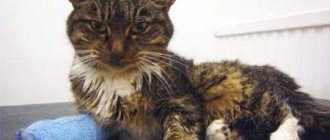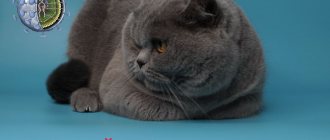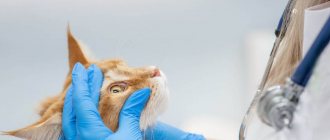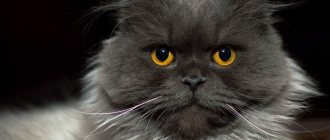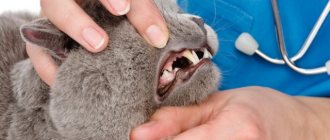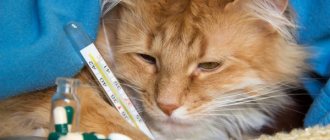Kidney diseases in cats are serious and dangerous pathologies that can lead to the death of the animal. They cause destruction of organ tissue, causing it to cease to perform its functions. The kidneys lose their ability to remove toxins from the blood, secrete urine, and maintain water-salt and acid balance. If you do not notice and ignore the signs of kidney disease in cats, the development of chronic renal failure (CRF), disability and death of the animal is possible.
Kidney structure
The kidneys are a paired oval (bean-shaped in dogs) organ, which in cats is located in the abdominal cavity, in the center of the back (at the level of 7-8 ribs), on both sides of the spine. In this case, the left half may have greater mobility.
The kidneys are made up of nephrons, each of which contains a glomerulus (a collection of capillaries) and a system of tubules. Each nephron is reliably protected from damage by a capsule.
Externally the kidneys look like this:
- The organ is protected from damage by a fibrous capsule, which in turn is located in a fatty capsule, whose thickness depends on the weight of the animal.
- The portal includes the renal artery, through which blood enters the kidneys for purification.
- The renal vein, ureter, and lymphatic vessels emerge from the organ.
- The ureter begins in the renal pelvis and discharges the resulting urine into the bladder.
Causes
There are many causes of nephritis, but the most common signs of the disease in cats are:
- Incorrect use of medications.
- Poisoning with household chemicals.
- Poor nutrition or poisoning from poor quality food.
- Damage to the body by helminthic infestation.
- Hypothermia, injuries, etc.
© shutterstock
Note. Most often among animals, cats are susceptible to nephritis; for example, in dogs this disease appears 3 times less often.
Kidney functions
The main job of the kidneys is to remove toxins from the body. It also forms urine, which contains:
- excess liquids, mineral salts, organic substances;
- uric acid;
- urea;
- ammonia, other metabolic products.
Urine flows down the ureters into the bladder, then comes out during emptying.
Other features
- Maintaining water, electrolyte, acid-base balance;
- regulation of blood pressure;
- removal of excess calcium;
- production of the active form of hormone D;
- synthesis of the hormone erythropoietin, which is responsible for the creation of red blood cells in the bone marrow.
Prevention
Prevention consists of organizing, maintaining comfortable living conditions and balanced feeding. The cat should not be treated to fried, salty, spicy foods, or overfed with scraps of meat and raw fish.
It is necessary to choose the type of feeding, and not mix natural products with ready-made factory-made feed. The cat is dewormed quarterly and protected from infectious diseases by vaccination according to the vaccination plan. If kidney disease is suspected, seek veterinary help.
Common kidney pathologies in cats
If the kidneys do not work properly, the body begins to malfunction, which can lead to serious problems. The most dangerous lesion is acute or chronic renal failure, untimely treatment of which leads to death. The acute form occurs quickly and is usually a consequence of poisoning.
Chronic kidney disease in cats takes a long time to develop, so it occurs mainly in older animals. It is usually a complication of other diseases of this organ:
- Pyelonephritis is an inflammation of the kidneys caused by bacteria, usually a consequence of cystitis (inflammation of the bladder).
- Polycystic disease is a congenital pathology, often found in pets with long hair.
- Poisoning. Causes include poisonous plants (lilies), pesticides, cleaning products, human medications harmful to animals (ibuprofen, vitamin D).
- Stones in the kidneys or urinary tract that interfere with the flow of urine from the organ.
- Glomerulonephritis – damage to the glomeruli.
- Neoplasia is a tumor, the most common is lymphosarcoma.
- Amyloidosis is an accumulation of protein in an organ that impairs its function.
In retrospective studies, where cats over 7 years of age predominated, no sex or breed predisposition was identified [1].
The experience of our veterinary center confirms the data given by Di Bartola. Among our patients, animals older than 7 years also predominated; males and females were encountered with equal frequency.
In veterinary clinics, cats with chronic renal failure among all patients range from 10 to 30% [3]. In our clinic, cats with chronic renal failure in the therapeutic department account for about 28-30% of the total number of patients.
Etiology
CRF develops where there is long-standing, irreversible damage to the kidneys, as a result of which they lose their excretory (removal of metabolic products), regulatory (maintaining the volume and composition of fluid in the body) and endocrine functions (production of the hormones renin, erythropoietin, etc.).
The causes of chronic renal failure are primary or secondary renal processes, which, as a rule, continue for a long time and lead to the final stage - a shriveled kidney. Such as:
- polycystic kidney disease (hereditary disease, mainly in Persian and exotic cats),
- inflammatory kidney diseases (pyelonephritis, glomerulonephritis),
- metabolic diseases (diabetes mellitus in cats and dogs, amyloidosis),
- urolithiasis disease,
- congenital underdevelopment of the kidneys (hypoplasia)
- kidney tumors - for example, lymphoma,
- other causes, such as kidney damage from toxins.
In the photo: Polycystic kidney disease, kidney disease in cats. Examination with Omnipaque 300 contrast agent.
However, in most cases, the exact cause of the disease in cats is unknown.
Pathogenesis
In the pathogenesis of chronic renal failure, regardless of renal pathology, a decrease in renal function occurs due to 3 main mechanisms:
- decrease in the number of functioning nephrons,
- a significant decrease in filtration rate in each individual case without reducing the number of nephrons,
- combinations of the first and second mechanisms.
The consequence of each of these factors will be a decrease in the glomerular filtration rate - the rate at which substances are filtered from the blood through the glomeruli of nephrons. A decrease in the number of functioning nephrons gradually leads to a significant change in biochemical blood parameters and severe metabolic disorders.
The development of uremia is noted with the accumulation of potential toxins and products of protein metabolism: urea (more than 10 mmoll [2]), creatinine (more than 179 mmoll [3]), uric acid.
According to modern concepts, uremic intoxication syndrome is not caused by the retention of nitrogenous wastes, but mainly by the accumulation in the blood of medium molecules - protein substances with a molecular weight of 300 to 500 daltons, formed as a result of a violation of the homeostatic function of the kidneys [5].
An increase in the products of nitrogen metabolism in the blood - osmotically active substances - increases the osmotic load on the remaining nephrons. These substances, having been filtered in the glomeruli, are reabsorbed in the tubules to a lesser extent than normal. The unreabsorbed part is excreted in the urine along with an appropriate amount of water. This is called osmotic diuresis. Due to osmotic diuresis, the total excretion of water by the kidneys not only remains normal, but can even be increased (polyuria), despite a significant decrease in glomerular filtration. The density of urine decreases and becomes stable at the level of 1.008-1.015, which corresponds to the density of blood and indicates a decrease in the concentrating ability of the kidneys.
Polyuria causes the body to lose water (dehydration). With dehydration, renal blood flow decreases, glomerular filtration worsens and chronic renal failure worsens. With chronic renal failure, the metabolism of calcium and phosphorus is disrupted. As chronic renal failure progresses, calcium excretion in the urine and its absorption in the intestine decrease, and the phosphate content in the blood increases. These disorders are accompanied by changes in bone tissue - osteodystrophy. Disorders of electrolyte metabolism lead to changes in the neuromuscular system, accompanied by adynamia, paralysis and other disorders. CRF is accompanied by changes in all types of metabolism. In the early stages, energy metabolism is disrupted - energy consumption exceeds the capacity for energy production.
Stages of kidney failure in cats
1. Latent stage of kidney disease (early).
Characterized by a decrease in glomerular filtration rate, but this does not affect the general condition of the animal and the concentration of creatinine in the blood
2. Initial stage of chronic renal failure.
Moderate azotemia is observed, the concentration of creatinine in the blood serum is up to 250 µmol/l. The progression of this stage of the disease can last several months and is accompanied by decreased appetite, loss of body weight, and periodic vomiting. Compensation can cause hyperparathyroidism, a decrease in the concentrating ability of the kidneys.
3. Conservative stage of chronic renal failure.
There is a further decrease in the glomerular filtration rate, high uremia develops, the concentration of creatinine in the blood serum is 252 - 440 µmol/l. At this stage, polydipsia is characteristic; clinical signs of dehydration, anemia, gastrointestinal dysfunction, and metabolic acidosis may appear.
4. Terminal stage of chronic renal failure.
The terminal stage of chronic renal failure is indicated not only by high levels of urea and creatinine in the blood, but also by hypocalcemia (up to the development of seizures), symptoms of uremic encephalopathy, hyperphosphatemia, a picture of decompensated uremic acidosis (Kussmaul breathing), interstitial pulmonary edema. With prolonged severe azotemia, life is impossible without dialysis or kidney transplantation [2].
According to Douglas Slatter, there are 3 phases of renal failure.
1st phase. Kidney diseases that primarily damage the kidney tissue (glomerulonephritis, urolithiasis, hypertension). Does not have a significant effect on the life of the animal and does not affect the concentration of creatinine in the blood.
Phase 2. Renal failure with minor clinical manifestations. Creatinine level 179 – 354 µmol.
Phase 3. Uremia, with obvious clinical manifestations and blood creatinine over 354 μmol.
In our practice, we conventionally divided chronic renal failure into three stages according to the level of creatinine in the blood:
1. Initial stage - when the creatinine level does not rise above 250 µmol - in such animals there may be no clinical manifestations of the disease, or they are insignificant. There were 38% of such cats over the past year (of the total number of cats suffering from chronic renal failure).
2. Medium – blood creatinine level up to 500 µmol. There are obvious clinical signs of the disease (polyuria, polydipsia, gastrointestinal dysfunction, anemia, exhaustion). There are about 28% of such cats.
3. Terminal – creatinine level above 500 µmol. A full range of clinical signs, including lethargy. Such cats make up 34% of the total number of chronic renal failure patients.
Clinical signs
Anorexia, depression
Vomiting due to hyperacid gastritis, polydipsia, polyuria. Gingivitis with ulcers on the tip of the tongue. Anemic mucous membranes. Secondary hyperparathyroidism with softening of the bones of the facial skull is observed.
Constipation, dehydration
Upon palpation, you can detect a change in the size of the kidneys; most often they are reduced; if chronic renal failure is caused by amyloidosis, hydronephrosis, tumors, an enlargement of the kidneys is observed.
Uremic encephalopathy: coma, tremor, epileptiform seizures, teteany.
Arrhythmia bradycardia. Increased blood pressure, hypertrophy of the left half of the heart. Acidosis causes deepening of breathing.
Immune depression, soft tissue calcification, bleeding disorders, insulin resistance (increased blood glucose levels), pancreatic dysfunction (hyperamylasemia). Thinning hair, poor coat quality.
Lethargy is observed in cats with end-stage chronic renal failure.
Diagnostics
CRF can be diagnosed in an animal by clinical symptoms, but they can also be non-specific, because Depression, lethargy, lack of appetite and weight loss are observed in many diseases. Laboratory tests are required to confirm the diagnosis. In our clinic, we most often use biochemical and clinical blood tests and urine tests, and in many cases we perform ultrasound examination of the kidneys.
Blood chemistry
Elevated levels of urea, urea nitrogen and creatinine are determined. The determination of creatinine in the blood is more important than the determination of urea, because the level of creatinine is not influenced by diet or the level of protein breakdown.
You can also determine the glomerular filtration rate: the volume and concentration of creatinine in urine per day is determined and correlated with the level of creatinine in the blood serum.
Symptoms of lack of appetite are observed when the urea level is more than 25 mmoll; when the urea content is 40 mmoll (the norm is 5-10 mmoll), the animal will experience severe depression and anorexia.
Insufficient excretion of limiting phosphorus leads to an increase in its level in the blood, while the calcium level falls (with moderate chronic renal failure, the phosphorus level is no more than 2.1 mmoll, with severe chronic renal failure more than 3.2 mmoll).
The release of calcium from bones when phosphorus levels are high leads to soft tissue mineralization. Most cats with chronic renal failure exhibit hyponatremia or hypokalemia, hypoalbuminemia, and hyperamylasemia. Non-regenerative anemia, hypokalemia. Isosthenuria, urine density 1008 and below.
Clinical blood test for cats and dogs
The following picture prevails: non-regenerative anemia caused by a decrease in the production of erythropoietin by the kidneys and a decrease in the lifespan of circulating red blood cells, leukocytosis with lymphopenia and thrombopenia.
Animal urine analysis
Isosthenuria (osmolarity is usually below 1015), pH changes to the acidic side, proteinuria, inactive urinary sediment, rarely glycosuria.
Ultrasound examination, ultrasound
Increased echogenicity of the renal parenchyma, blurring of the boundaries of the cortical and medial layers, reduction in the size of the kidneys.
X-ray examination
A decrease in the size of the kidneys is determined to be less than 2.5 times the length of the body of the second lumbar vertebra (L-2). If overt hyperparathyroidism is observed, a decrease in bone density, especially in the maxilla, and soft tissue calcification are visible.
Differential diagnosis
Differentiate from acute renal failure (ARF), prerenal and postrenal uremia.
In acute renal failure, there is no anemia, polyuria and polydipsia, or kidney shrinkage, but there are anamnestic signs of an extrarenal underlying disease.
Glomerulonephritis is combined with severe proteinuria, while the kidney size is normal, with a tendency to edema.
In case of pyelonephritis, urine analysis shows active urinary sediment, pyuria. The kidneys may be irregularly shaped, and the pelvis and ureters are dilated on ultrasound. Blood leukocytosis.
For polydipsia without urea retention, Diabetes mellitus, Dibetes isipidus centralis and renalis, psychogenic craving for drinking.
During histopathological examination of the kidneys (biopsy) in acute renal failure, the following is observed:
- acute tubular necrosis
- acute inflammation
For chronic renal failure:
- a significant part of the normal parenchyma is replaced by fibrous tissue,
- extensive tubular atrophy,
- calcification of basement membranes,
- chronic inflammation (chronic interstitial nephritis),
- glomerulosclerosis
Treatment
Most often, kidney disease in cats is diagnosed without a clear idea of its cause, so treatment is aimed at eliminating the main symptoms. Goals of therapy:
- maintaining quality of life,
- slowing down the degeneration of damaged kidneys and the progression of chronic renal failure,
- reduction of azotemia,
- reduction of proteinuria,
- reducing the risk of hypertension.
Anorexia and dehydration: intravenous or subcutaneous administration of solutions of 0.18% sodium chloride + 4% dextrose. The required volume of administered solutions is calculated based on the need for 50 mlkg24 hours
Systemic hypertension: ACE inhibitors or calcium channel blockers (enalapril 0.25-0.5 mgkg per os, every 12-24 hours, amlodipine 0.10-0.25 mgkg per os, every 24 hours).
Metabolic acidosis: sodium bicarbonate 8-15 mgkg per os, every 8-12 hours.
Hypokalemia: Hartmann's solution, Panangin.
Hyperphosphatemia: low phosphorus diet (Royal Canine renal, Hill's kd, Eucanuba renal, Pro Plan NF), phosphorus content no more than 0.6% of the daily diet. Administration of drugs that bind phosphorus into the gastrointestinal tract: aluminum hydroxide 30-60 mgkg per day with food.
Weight loss: high-calorie diet, appetite stimulation with various taste attractants, parenteral nutrition, nasoesophageal tube
Proteinuria and hypoalbumemia: ACE inhibitors enalapril 0.5 mgkg per os, every 12-24 hours - reduce protein excretion by the kidneys when they are damaged. A diet rich in omega 3 polyunsaturated fatty acids.
Immune suppression: annual vaccination and protecting the animal from potential sources of infection.
Decreased appetite and vomiting: a diet with a reduced level of protein with a urea level of more than 40 mmol, H2 receptor antagonists (famotidine 0.5 mgkg per os, every 12-24 hours, metoclopramide 0.2-0.4 mgkg per os, subcutaneously, every 6-8 hours.
Anemia: with hematocrit below 18%, erythropoietin 25-100 units kg, subcutaneously 1-3 times a week, ferrous sulfate 5-20 mg kg per day per os.
conclusions
1) CKD is the irreversible progressive destruction of kidney tissue as a result of diseases that, in the absence of dialysis or kidney transplantation, lead to the death of the patient.
2) Cats with chronic renal failure may not have symptoms until the glomerular filtration rate becomes very low.
3) The consequence of chronic renal failure is a violation of the metabolism of water and sodium, calcium and phosphorus, anemia.
Literature
1. Di Bartola, SP, Tarr, MJ and Benson, MD: Tissue distribution of amyloid deposits in Abyssinian cats with familial amyloidosis. J. Comp. Pathol. 96:387-398, 1986.
2. Candler EA, Gaskell CJ, Gaskell RM “Feline medicine and therapeutics”, Blackwell Science, 1994, p. 118-121
3. Douglas Slatter “Small animal surgery”, Saunders, 2003, p. 1562-1616
4. Paula Hotston Moore “Fluid therapy for veterinary nurses and technicians” Butterworth Heinemann, 2004, p. 11-41
5. Nephrology. Ed. E. M. Shilova. M.:GEOTAR-Media, 2007, p. 599-612.
Causes of kidney disease in cats
Problems can be caused by both primary and secondary causes:
- Genetic factor - Abyssinian cats and Persians are predisposed to kidney disease.
- Viral infections – feline leukemia (FeLV) or feline infectious peritonitis (FIP).
- Heart failure, which is accompanied by low blood pressure, which reduces blood flow to the organ.
- Trauma associated with a pelvic fracture or bladder rupture.
- Bacterial infections, due to which pathogens were able to get close to the kidneys - chronic periodontal disease, inflammation of the uterus, pancreatitis, endocarditis.
- Worms.
- Autoimmune diseases – lupus erythematosus.
Characteristic signs
The symptoms of leukemia are varied. The following signs raise suspicion:
- digestive disorders;
- inflammation of the gums;
- constant illness;
- disheveled fur, oppression;
- enlargement of local lymph nodes;
- anemia;
- eye lesions;
- salivation;
- abortions;
- infertility;
- tumors.
- paresis of the limbs.
Symptoms of kidney disease in cats
Early signs of kidney disease in cats can indicate any other pathology - lethargy, apathy, dull hair, and sometimes baldness. One of the first obvious symptoms of kidney disease in cats is frequent or infrequent urination. In the first case, the urinary system does not retain fluid well. In the second, problems with the formation of urine or stones (tumor) block its outflow.
Other symptoms of kidney disease in cats that indicate the need for treatment include:
- painful urination;
- involuntary emptying outside the tray;
- strong thirst;
- loss of appetite, weight loss;
- mouth ulcers;
- brown tongue
In later stages appears:
- vomiting, diarrhea or constipation, bloody or cloudy urine;
- unpleasant odor of ammonia from the mouth.
Types of jade
Inflammation of the kidneys is distinguished by the severity of the process. It can be manifest or chronic. Depending on the tissue damage, the following types of disease are distinguished:
- Glomerulonephritis. The kidney glomeruli are destroyed and gradually die.
- Pyelonephritis is a purulent inflammation of the renal pelvis.
- Interstitial. In this case, the kidney tubules become inflamed and urine filtration is impaired. It is rare in cats.
Diagnosis of kidney problems in cats
Kidney disease in cats is usually diagnosed based on blood tests for urea and creatinine levels. These protein breakdown products can only be excreted from the body through urine. Therefore, their increased amount in the blood indicates problems with the kidneys. The degree of damage is determined by the number of creatinine, since an increase in urea does not always correspond to the severity of the pathology.
To determine pyelonephritis and other diseases, you need to do a pet urine test for the presence of albumin in the blood. The more protein in the urine, the worse the situation. To diagnose pyelonephritis and other pathologies, it is necessary to do an ultrasound, x-ray, and biopsy.
Until recently, early diagnosis of chronic renal failure was a difficult task. For an accurate diagnosis there were few clinical symptoms, increased levels of nitrogen, urea, and creatinine in the blood. By their level, it was possible to determine CKD only when the organ almost completely failed.
Now there is a blood test SDMA (SDMA), which allows you to determine the loss of kidney function by 25%. Its level rises long before the rise in creatinine in the blood. Even if the kidneys of cats and dogs are slightly damaged, the test can determine the presence of diseases that adversely affect the organ.
Diagnostics
A veterinarian diagnoses feline nephritis. To clarify the nature of the problem, it is often necessary to exclude a number of other pathologies that may have similar symptoms. Diagnosis of the disease begins with examination of the animal and palpation of the kidney area.
The specialist collects anamnesis to determine the conditions in which the cat lives and what food and water it consumes. To identify the problem and the cause of its occurrence, specific tests and examinations are prescribed, including:
- general and biochemical blood and urine tests;
- electrophoresis;
- Ultrasound of the kidneys;
- radiography.
If necessary, additional studies such as MRI and kidney tissue biopsy are prescribed.
Treatment of kidney disease in cats
When treating kidney disease, the veterinarian will pay attention to the level of electrolytes in the blood. You may need to take the following medications:
- Medicines for phosphorus binding are prescribed if the analysis shows their elevated levels in the blood. Reducing phosphorus improves the pet’s well-being and slows down the progression of the disease.
- Potassium supplements. Animals with renal pathology often lose potassium in the urine, which leads to muscle weakness, deterioration of coat condition, and chronic renal failure.
- Vitamins B and C. When the organ stops concentrating urine, they dissolve in urine and are excreted from the body. Therefore, pets need daily supplements.
- Antiemetics are prescribed for the treatment of animals that suffer from disorders of the digestive system.
- Medicines to lower blood pressure. Many pets with kidney failure have elevated blood pressure, which leads to organ destruction.
- Medicines to treat anemia. The kidneys stimulate the synthesis of red blood cells in the bone marrow. When an organ is destroyed, the level of red blood cells drops. This leads to oxygen starvation and disruption of oxidative processes. Treatment with special drugs is aimed at restoring the level of red blood cells in the blood.
- Feed additives that support kidney function - Renal paste, Renaletten.
What to do first
If such a disease is detected, the pet, of course, may be prescribed medication. Both nephritis in cats, the symptoms of which were discussed above, and other diseases of the genitourinary system, with the correct selection of drugs and when used according to the regimen prescribed by the doctor, go away quite quickly.
A cat with such a pathology, of course, should first be shown to a veterinarian. In any case, after detecting symptoms, your pet should immediately be put on a starvation diet. Also, the animal must be kept warm.
A sick pet should be fed frequently. At the same time, the cat’s diet should definitely include foods that contain large amounts of potassium, calcium and carbohydrates and are low in table salt and protein. It would be a good idea to give a sick cat, for example:
- low-fat fermented milk products (kefir 1%);
- cereal and vegetable porridges;
- low-concentrated meat broths.
In case of acute nephritis in cats, fried, salted, smoked and baked foods should never be given to pets. Also, owners of such animals will have to refuse to purchase industrial feed. In case of an acute form of the cat, you can try to help by replacing the water in its drinking bowl with a decoction prepared from diuretic medicinal herbs.
Diet for cats with kidney disease
When the kidneys are sick, the pet suffers from dehydration. During treatment, be sure to provide him with water - give him wet food, low-sodium broth, tuna juice.
Particular attention should be paid to a diet low in protein and phosphorus. Ask your veterinarian how to feed your pet correctly. The diet should contain a reduced amount of phosphorus and protein, enriched with omega-3 fatty acids.
If you give dry cat food, it is not advisable if you have kidney disease. Give preference to high quality wet food. For example, Dr. has proven himself well. Clauder's Diet Kidney diet for kidney disease. If your pet has stones, for treatment, buy food for cats with kidney disease, which reduces the risk of stones.
Therapeutic measures
Let us immediately note that self-treatment is strictly contraindicated, especially for infectious nephritis. It is necessary to conduct research and take tests. An ultrasound examination of the affected kidneys will not hurt. All this is done to determine the exact type of pathology. This determines how to treat a sick animal. It is simply impossible to do all these manipulations at home, so immediately take your pet to a veterinary clinic. However, there are some recommendations for owners, following which you can alleviate the animal’s condition. Firstly, diet. Dry food, as well as salty, smoked, and fried foods should be excluded from the cat's diet. This is what to feed a cat with nephritis.
If the animal has been treated with something, immediately inform the veterinarian, who will decide whether to continue therapy or stop using the drug. The cat needs to be given complete rest and provided with plenty of clean, cool water. If antibiotic therapy is carried out (and this is probably the case!), then water will become especially important.
Prevention of kidney disease in cats
- Do not keep the animal in cold or drafty conditions.
- Give deworming medications in a timely manner, even if the pet does not leave the apartment.
- Don't forget about annual vaccinations.
- Keep your pet away from household poisons. Hide medicines, flowers (lilies), and household chemicals that could cause poisoning to your cat.
- Feed the animal regularly (2 times a day).
- Discuss your pet's diet with your veterinarian. Give the animal high-quality food, do not overfeed.
- Change the water daily.
- Provide constant access to the tray to avoid urolithiasis. Don't forget to clean it.
- Play with your pet to prevent obesity. Buy special toys for games. A sedentary lifestyle is the cause of stagnation and many diseases.
- Treat kidney and urinary system diseases in cats in a timely manner.
- If your animal is at risk (old age, breed prone to kidney disease), immediately adjust its diet and monitor your pet’s health.
Treatment: which methods are effective?
Use of pharmaceuticals
All medications and dosage are prescribed by a doctor; self-medication leads to the death of the animal. Treatment of nephritis in cats includes a set of medications shown in the table:
| Pharmgroup | Medication |
| Antibiotics | "Amikacin" |
| "Erythromycin" | |
| "Gentamicin" | |
| "Amoxiclav" | |
| "Amoxicillin" | |
| "Vetrimoxin" | |
| Diuretics | "Furosemide" |
| "Veroshpiron" | |
| "Amiloride" | |
| "Torasemide" | |
| Potassium acetate | |
| Magnesium sulfate | |
| Vitamin complexes | "Aminosol" |
| "Fort Dodge Dufalight" | |
| "Gepavi-kel" | |
| "Tetravit" |
Medical nutrition
Among the abundance of medicinal foods, the owner can choose Purina Veterinary Diets and switch the pet to it.
If you have nephritis, you should exclude salty, smoked, fried, fatty foods from your cat’s diet, and reduce the amount of protein foods. The animal should eat fractionally, in small portions. The menu should include low-fat cottage cheese and kefir, cereal porridge, boiled vegetables and lean broth. Among feeds, preference should be given to those produced for kidney diseases. These include:
- Purina Veterinary Diets;
- Hill's Prescription Diet;
- "Advance";
- Royal Canin;
- "Farmina."
Herbal treatment
The use of herbal infusions for nephritis in cats is mandatory, since herbal remedies accelerate the penetration of antibiotics into the renal structure.
The decoction should be given to the cat through a syringe without a needle, in small portions so that the animal can swallow without choking. Inflammation of the kidneys should be treated with herbs such as bearberry, lemongrass, knotweed, dandelion, immortelle, and flax seeds. You can prepare each herb separately or make a mixture by mixing them in equal proportions. Juniper berries are effective and can be added to food. Preparation:
After brewing bearberry, the owner can give the pet this drink several times a day. Take 5 g of any plant or mixture, pour 200 ml of boiling water.- Let it brew for 20-30 minutes, cool, filter.
- Dilute the resulting broth with boiled water.
- Drink 10-15 ml 3-4 times. per day.
Useful materials:
- Cloudy eye in a cat Common causes of cloudy eyes in a cat The most common causes of cloudy eyes are glaucoma, cataracts or keratitis.…
- Cutaneous horn General description of the disease Cutaneous horn on the forehead or face (ICD 10 code - L57.0) -...
- Itching and odorless discharge Main causesBefore considering the factors that provoke the appearance of discharge that has a sour odor, it is necessary to immediately note...
- A cat’s liver How to determine that there is a malfunction in the liver All harmful substances that enter the cat’s body with ...
Diagnosis and treatment of nephritis in Moscow
The Clinic of JSC "Medicine" invites patients with suspected nephritis to undergo a comprehensive examination and course of treatment. All necessary services can be obtained at the center, which will save the patient from having to sign up for tests and wait a long time for his turn. Each patient is guaranteed confidentiality, attentive and welcoming treatment, the opportunity to undergo examination and receive advice from other specialized specialists, as well as the quality and safety of the proposed treatment procedures. You can make an initial appointment by calling the specified phone number or through the clinic’s website by filling out the appropriate application.
Treatment of kidney failure
Chronic renal failure cannot be completely cured. By controlling the development of the disease, you can improve the animal’s condition and prolong its life. Treatment tactics depend on the stage of the disease.
If the pathology was detected in the initial stage, it will be necessary to provide the cat with monitoring of vital signs: measure body weight, blood pressure, and monitor the general condition every few months. The problem in this case may be loss of appetite due to the need to follow a “tasteless” diet.
At stages 3-4, if there are no severe clinical manifestations, the therapy will be the same. However, in case of an unstable condition, the cat will have to be brought out of the decompensation stage in a hospital setting. The treatment plan will depend on the symptoms:
- In case of dehydration, infusion therapy is carried out; for this, the cat is given an intravenous catheter.
- Antiemetics (Maropitant, Metoclopramide) are prescribed for vomiting cats.
- If the hematocrit level is very low (anemia), a blood transfusion (blood transfusion) may be prescribed.
- Painkillers are used to relieve pain and inflammation.
After achieving positive dynamics, the cat is prescribed a course of long-term therapy: injections of electrolyte solutions are prescribed to restore water-salt balance, as well as drugs that replenish protein loss.
Renin-angiotensin-aldosterone system (RAAS) and CKD
The renin-angiotensin-aldosterone system, or RAAS, is a sequence of hormonal reactions aimed at maintaining blood pressure within a narrow normal range. Strict blood pressure control is achieved by maintaining a balance between the following processes:
- Vasoconstriction
- Vasodilation
- Control of extracellular fluid volume and blood volume by excretion or retention of sodium and water.
Angiotensin II is the active end product of a cascade of hormonal reactions. It binds to angiotensin II receptors on the surface of cells in various tissues and causes various biological effects, which are depicted in Fig. 3.
Rice. 3. Renin-angiotensin-aldosterone system (RAAS) and its effect on homeostasis
